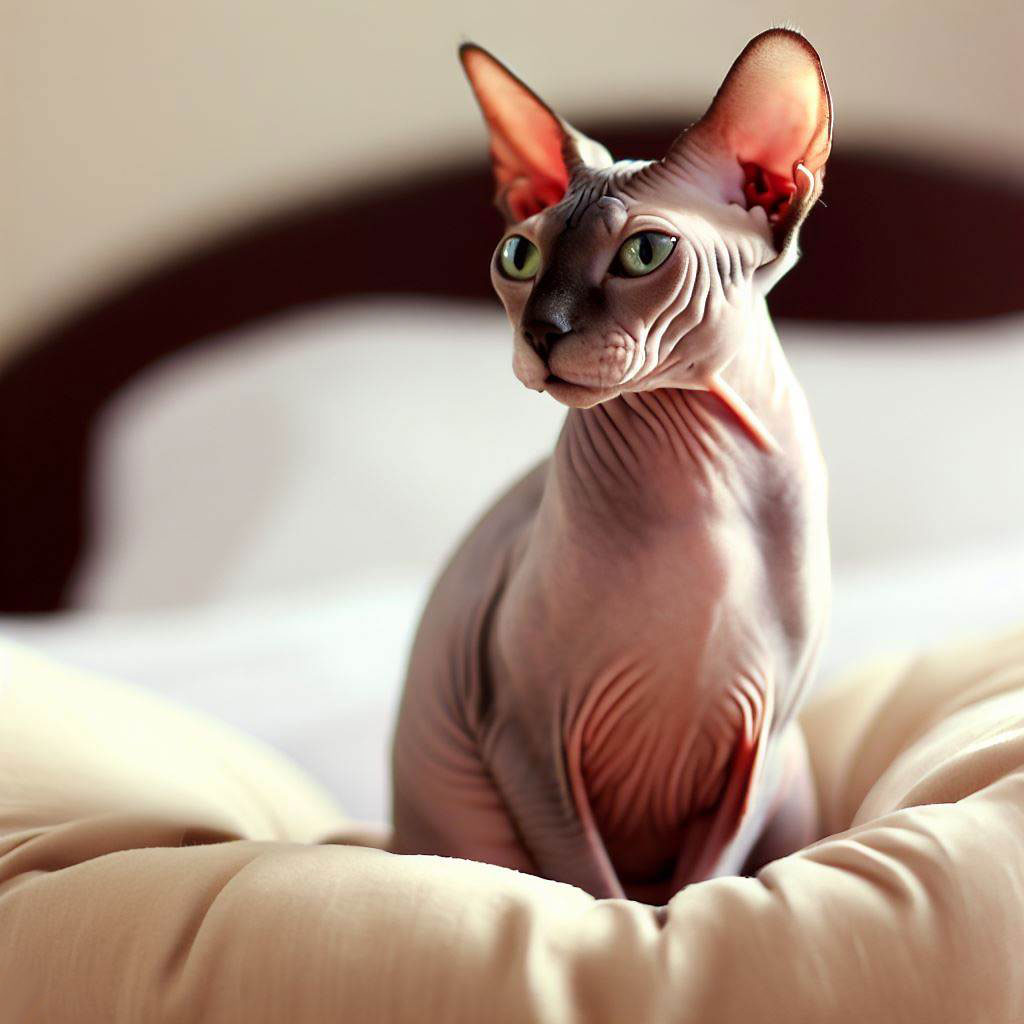Are Hairless Cats Hypoallergenic?
If you suffer from cat allergies but still long for feline companionship, you may have wondered, “Are hairless cats hypoallergenic?” This common question has led many cat enthusiasts to explore the world of hairless cat breeds.
Table of Contents
Introduction: Understanding the Hypoallergenic Myth
In our article, we will delve into the truth about hypoallergenic cats, dispel misconceptions, and discuss crucial considerations before making the decision to bring a hairless cat into your home.
Explanation of Hypoallergenic Cats
Before we address the hypoallergenic nature of hairless cats, let’s clarify what “hypoallergenic” means in the context of feline companions. Contrary to popular belief, hypoallergenic does not equate to allergy-free. Hypoallergenic cats are those that are less likely to provoke allergic reactions in some individuals. Cat allergies primarily arise from allergens present in a cat’s saliva, skin, and urine, not necessarily from their fur.
The main culprit responsible for triggering cat allergies is a protein called Fel d 1, which is produced by cats and present in their bodily secretions. When cats groom themselves, they transfer this allergenic protein onto their skin, which then gets dispersed around their environment.
Imagine you visit a friend who owns a hairless cat, such as a Sphynx or a Bambino. Although they may not shed much fur, these cats still groom themselves, spreading allergens onto their skin. Consequently, spending time in their home may cause allergic reactions if you are sensitive to Fel d 1 proteins.
Importance of Understanding Allergies Before Owning a Hairless Cat
While hairless cats may seem like a potential solution for cat allergy sufferers, it’s vital to conduct thorough research and consider a few essential factors before bringing one into your life.
- Personal Allergies: Allergies vary from person to person, and individuals may have different degrees of sensitivity to cat allergens. Before committing to a hairless cat, it’s essential to assess your specific allergies through allergy testing and consultation with a healthcare professional.
- Exposure and Sensitization: Spending time with hairless cats and interacting with different breeds in controlled environments can help gauge your response to their allergens. Frequent exposure to cat allergens may lead to desensitization over time, but this is not the case for everyone.
- Maintenance and Grooming: While hairless cats may shed less fur, they still require regular grooming to maintain healthy skin. This grooming process can distribute allergens throughout your living space.
- Environmental Management: Implementing allergen-reduction strategies in your home, such as using air purifiers, frequent cleaning, and limiting the cat’s access to certain areas, can help mitigate allergic reactions.
Example: Suppose you undergo allergy testing and discover that you are mildly allergic to cat allergens. You visit a cattery to spend time with hairless cat breeds like the Sphynx and the Donskoy. Over a few visits, you observe your allergic responses and consult your doctor about potential management strategies.
By understanding your allergies and considering these crucial factors, you can make an informed decision about whether a hairless cat is the right companion for you.
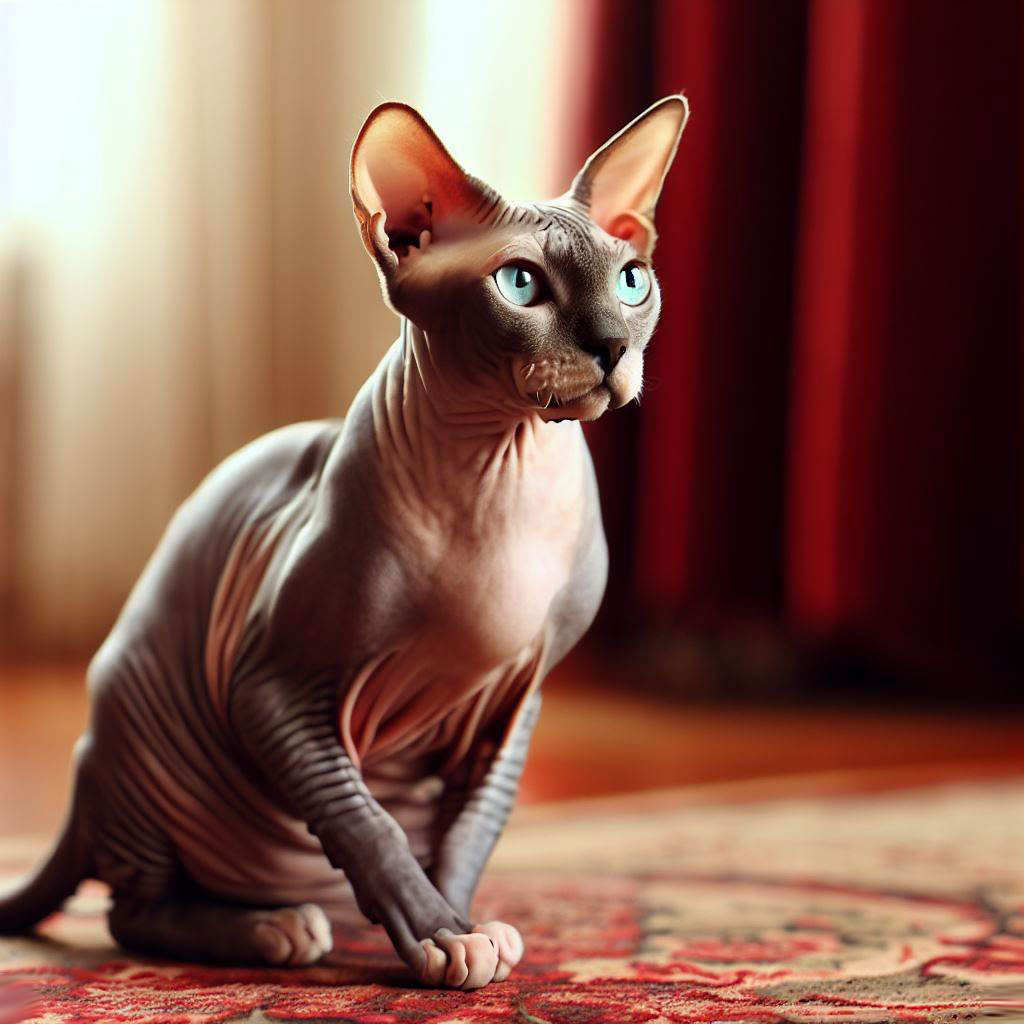
What Makes Hairless Cats Unique?
If you’ve ever encountered a hairless cat, you might have been captivated by its unique appearance and velvety skin. Here we will explore what makes hairless cats stand out, the genetic factors behind their hairlessness, and how they compare to regular cat breeds in terms of allergenic potential.
Characteristics of Hairless Cat Breeds
Hairless cat breeds, such as the Sphynx, Bambino, and Donskoy, possess distinct traits that set them apart from their furry counterparts. While each breed has its unique characteristics, there are some common features shared among hairless cats:
- Lack of Fur: As the name suggests, hairless cats are characterized by their lack of fur. Instead, they have a fine layer of downy hair or fuzz covering their bodies, which gives them a soft and warm texture.
- Wrinkled Skin: Many hairless cat breeds have wrinkled skin, particularly on their heads and bodies. These wrinkles add to their endearing appearance and make them truly one-of-a-kind.
- Large Ears and Eyes: Hairless cats often have prominent ears and large, expressive eyes, which enhance their striking appearance.
- High Body Temperature: Due to their lack of fur, hairless cats have higher body temperatures than regular cat breeds. They seek warmth from their human companions and cozy spots around the house.
Picture a Sphynx cat with its elegant, wrinkle-covered body, large ears, and striking almond-shaped eyes. Its unique look and soft, warm skin are undoubtedly captivating.
Genetic Factors Behind Hairlessness
The hairless trait in cats is a genetic mutation that occurs spontaneously. It’s important to note that not all hairless cat breeds have the same genetic origins. Here are some key genetic factors that contribute to hairlessness in specific breeds:
- Sphynx Cats: The Sphynx breed originated from a natural genetic mutation in Canada in the 1960s. This mutation affects the gene responsible for producing fur, resulting in their hairless appearance.
- Donskoy Cats: The Donskoy breed hails from Russia and also carries a dominant gene for hairlessness. Unlike the Sphynx, Donskoy cats can have varying degrees of hairlessness due to the presence of different alleles of the hairless gene.
- Bambino Cats: Bambino cats are a cross between the Sphynx and the Munchkin breed. Their hairlessness is inherited from the Sphynx parent.
Imagine learning about the fascinating genetic origins of hairless cat breeds and how a spontaneous mutation can lead to a unique and sought-after trait.
Comparing Hairless Cats to Regular Cat Breeds in Terms of Allergenic Potential
While hairless cats may appear to be a potential solution for those with cat allergies, it’s essential to understand that they are not entirely hypoallergenic. As mentioned earlier, cat allergies are primarily triggered by allergens present in a cat’s saliva, skin, and urine, not their fur.
Suppose you are considering adopting a hairless cat because you have mild cat allergies. It’s important to be aware that even hairless cats produce allergens, and you may still experience allergic reactions if exposed to their bodily secretions.
Despite their unique characteristics and genetic origins, hairless cats are not completely allergen-free. Before bringing one into your home, it’s crucial to spend time with different breeds, assess your allergic response, and consider environmental management strategies.

Allergies and Hairless Cats: Fact or Fiction?
Unraveling the Truth About Hairless Cat Breeds and Allergenicity
If you’ve ever dreamed of having a cat but suffer from allergies, you may have wondered, “Are hairless cats hypoallergenic?” Now we will explore the realm of cat allergies, dispel myths about hairless cats being completely hypoallergenic, and examine the factors contributing to allergenicity in hairless cat breeds.
Understanding Cat Allergies and Their Triggers
Cat allergies affect a significant number of individuals worldwide, making it crucial to comprehend their triggers. Allergic reactions are primarily caused by proteins present in a cat’s saliva, skin, and urine. The main allergenic protein is called Fel d 1, which is produced by cats to help keep their fur clean and maintain social bonding.
When cats groom themselves, they transfer these allergenic proteins onto their skin. As a result, when the cat’s skin comes into contact with surfaces around the house or when they shed fur, the allergens become airborne. When inhaled or contacted by individuals sensitive to Fel d 1, these allergens can lead to a range of allergic symptoms.
Imagine visiting a friend’s house with a regular long-haired cat. You may start sneezing, experience itchy eyes, or even develop a skin rash due to exposure to Fel d 1 proteins.
Dispelling Myths About Hairless Cats Being Completely Hypoallergenic
Hairless cat breeds, such as the Sphynx, Bambino, and Donskoy, have gained popularity as potential pets for those with cat allergies. However, it is essential to dispel the myth that hairless cats are completely hypoallergenic. While they may shed less fur, hairless cats still produce Fel d 1 allergens, albeit in smaller quantities compared to their furry counterparts.
Suppose you are considering adopting a hairless cat because you believe it will not provoke your cat allergies. It’s vital to understand that even though they lack fur, they still produce allergenic proteins and may cause allergic reactions.
Factors Contributing to Allergenicity in Hairless Cat Breeds
The allergenicity of hairless cat breeds is influenced by several factors:
- Saliva Production: Hairless cats groom themselves just like regular cats, leading to the deposition of allergens on their skin through their saliva.
- Skin Oils: The skin of hairless cats secretes oils that can carry allergens. When they rub against surfaces or their human companions, these oils can spread allergenic proteins.
- Urine Deposits: Cat urine also contains allergenic proteins. Although hairless cats may not produce as much dander as regular cats, their urine can still trigger allergic reactions if not cleaned appropriately.
Imagine adopting a Sphynx cat and noticing that it rubs against your furniture, leaving behind skin oils that might contain allergens. Although you love your new feline friend, you must be mindful of these potential allergens and manage them effectively.
Despite their unique appearance and reduced fur shedding, hairless cats are not hypoallergenic. If you are considering bringing a hairless cat into your life, it’s essential to be aware of their allergenic potential and take measures to minimize exposure to allergens.
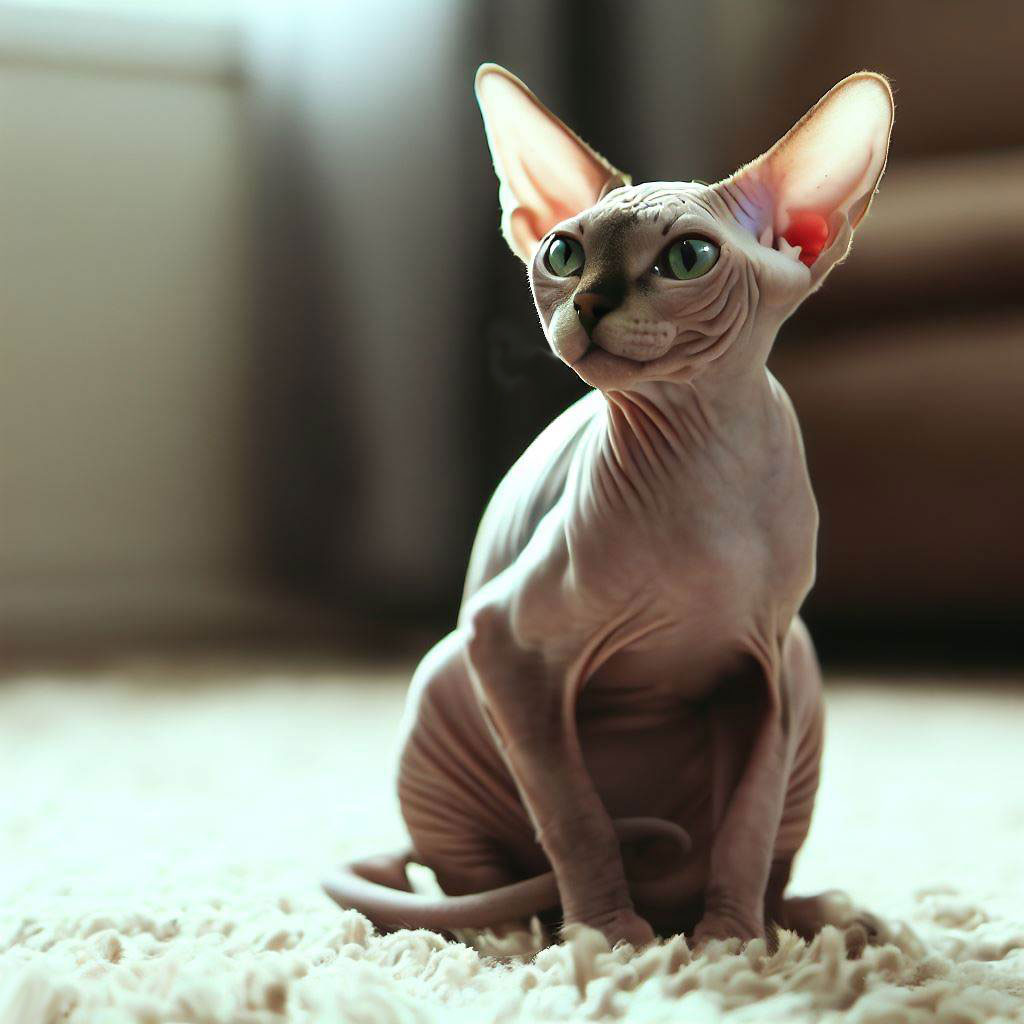
Examining Hypoallergenic Hairless Cat Breeds
We understand the significance of finding the right cat for allergy-prone individuals. We will now delve into the unique characteristics and care requirements of lesser-known hairless cat breeds, to help you make an informed decision about which one might be the best match for your lifestyle.
Sphynx Cats
Sphynx cats are one of the most well-known hairless cat breeds, and their history is as intriguing as their appearance.
Origin and History of Sphynx Cats
Contrary to popular belief, Sphynx cats are not entirely hairless; they have a fine layer of downy hair covering their bodies, which gives them their unique velvety texture. The origin of the Sphynx breed can be traced back to a natural genetic mutation in Canada during the 1960s. Breeding efforts were initiated to preserve and develop this distinctive trait, resulting in the Sphynx breed we know today.
Coat Care for Sphynx Cats
These felines require special care to maintain healthy skin and manage their fine coat. Regular bathing is essential to remove skin oils and reduce allergenic proteins. As Sphynx cats do not have fur to absorb oil, their skin can become greasy, leading to potential skin issues.
Allergenic Potential and Precautions
While Sphynx cats produce fewer allergenic proteins compared to regular cat breeds, it’s essential to note that they are not entirely hypoallergenic. Their skin still contains allergenic proteins that can trigger allergic reactions in sensitive individuals. Regular grooming and maintaining a clean living environment can help minimize allergen exposure.
Bambino Cats
Bambino cats are a relatively new breed and are a cross between the Sphynx and the Munchkin breed, resulting in a unique appearance and charming personality.
Unique Features of Bambino Cats
As the name suggests, Bambinos inherit their short legs from the Munchkin parent and their hairlessness from the Sphynx parent. As a result, giving them an endearing and playful appearance. Their affectionate and sociable nature makes them popular among cat enthusiasts.
Grooming Needs and Maintenance
Luckily for owners, Bambino cats have minimal grooming needs due to their lack of fur. However, regular skin care is crucial to prevent skin issues and to manage allergenic proteins.
Allergy Considerations for Bambino Cat Owners
As with all hairless cats, Bambinos are not entirely hypoallergenic. Despite their reduced allergenic potential, some allergy-sensitive individuals may still experience allergic reactions. It’s essential to spend time with Bambino cats before making a decision and maintain a clean living space to manage allergen exposure.
Donskoy Cats
Donskoy cats, also known as the Don Sphynx, have a unique wrinkled appearance and a friendly temperament.
Physical Traits of Donskoy Cats
There are variations with Donskoy cats. They can come in various coat types, ranging from completely hairless to having a velvety peach-fuzz-like coat. Their wrinkled skin adds to their distinctive charm.
Skin Care Tips for Donskoy Cats
The Donskoy cat require regular skin care to maintain a healthy coat. Moisturizing the skin can help prevent dryness and reduce allergenic proteins.
Allergies and Donskoy Cats: What to Expect
While Donskoy cats are considered to have a lower allergenic potential, they still produce allergenic proteins. Individuals with mild cat allergies may find them more manageable as companions, but it’s essential to consider potential allergic reactions before bringing a Donskoy cat into your home.
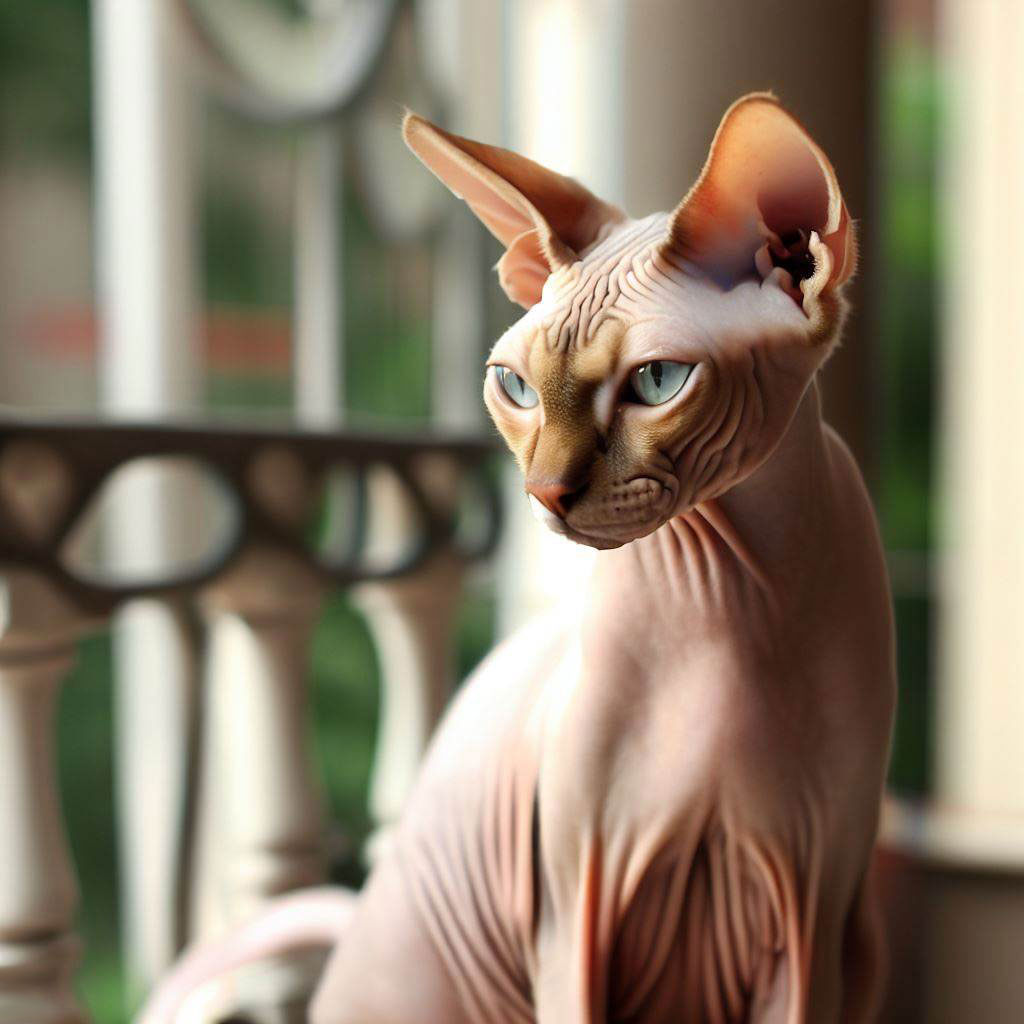
Peterbald Cats
Peterbald cats are another fascinating hairless breed with various coat types and a friendly demeanor.
Variations in Peterbald Coat Types
They can have different coat types, including hairless, velour, brush, and straight-coated. Each coat type requires specific grooming and care.
Best Practices for Peterbald Cat Owners with Allergies
As with other hairless breeds, Peterbald cats are not entirely hypoallergenic. However, their grooming needs and reduced shedding may make them more suitable for some individuals with mild cat allergies.
Other Health Considerations for Peterbalds
Peterbald cats are generally healthy, but it’s essential to provide them with a balanced diet and regular veterinary care to ensure their well-being.
Ukrainian Levkoy Cats
Ukrainian Levkoy cats are a rare and fascinating breed with distinctive features that set them apart from other hairless cats.
History and Rarity of the Ukrainian Levkoy Breed
This breed originated in Ukraine in the early 2000’s through selective breeding. They are characterized by their folded ears and hairlessness, making them a visually striking and relatively rare breed.
Handling Potential Allergic Reactions with Ukrainian Levkoy Cats
While Ukrainian Levkoy cats are known for their reduced allergenic potential, it’s essential to remember that they are not entirely hypoallergenic. Allergenic proteins may still be present in their saliva and skin oils. Spending time with this breed before adoption and maintaining a clean living space can help manage allergen exposure.
Temperament and Suitability as a Hypoallergenic Pet
Affectionate, intelligent, and social animals, Ukrainian Levkoy cats are excellent companions for allergy-prone individuals. Their playful nature and affectionate demeanor can bring joy to any household.
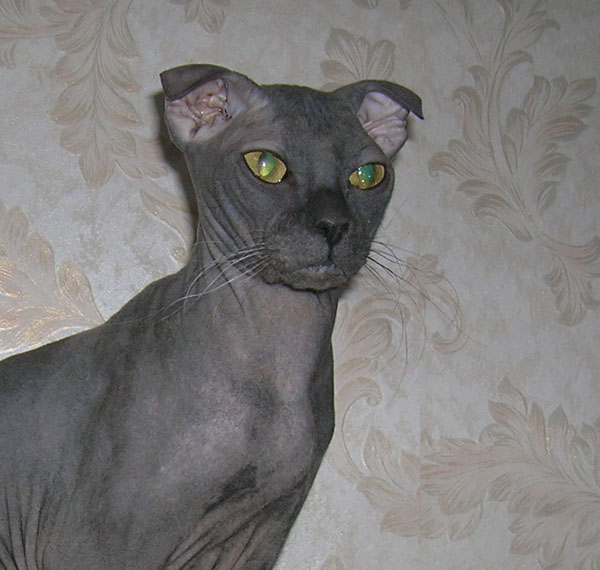
Elf Cats
Elf cats possess a unique appearance and charming personality that makes them stand out among hairless breeds.
Elf Cats’ Distinct Appearance and Traits
The Elf cat is a result of crossing the Sphynx with the American Curl breed, creating a captivating combination of hairlessness and distinctive curled ears. Their enchanting appearance and friendly disposition make them popular among cat enthusiasts.
Caring for Elf Cats’ Hairless Features
Regular grooming is required for Elf cats to maintain healthy skin and manage allergenic proteins. Despite their lack of fur, their skin can still become greasy, necessitating frequent baths and skincare.
Allergenicity and Elf Cat Ownership
This breed has a reduced allergenic potential compared to regular cat breeds, but they are not entirely hypoallergenic. If you are considering adopting an Elf cat, it’s essential to assess your allergic response and implement allergen-reduction strategies.
Devon Rex Cats
Devon Rex cats may not be hairless, but their unique coat and characteristics make them a contender for allergy-prone individuals.
Comparison of Devon Rex with Hairless Breeds
Many Devon Rex cats have a curly, short coat that sheds minimally compared to regular cat breeds. While they may not be entirely hairless, their reduced shedding can benefit allergy-sensitive individuals.
Grooming Needs and Managing Allergies with Devon Rex Cats
Unlike pure hairless cats, Devon Rex cats require regular grooming to keep their coat in good condition. Their reduced shedding can help minimize allergen exposure in the home.
Other Benefits of Having a Devon Rex
In addition to their hypoallergenic potential, Devon Rex cats are known for their playful and affectionate personalities, making them delightful companions for various households.
Dwelf Cats
Dwelf cats are a captivating blend of three breeds – the Sphynx, Munchkin, and American Curl – resulting in an adorable and unique appearance.
Characteristics of Dwelf Cats
Being a bit of a ‘mixa’, the Dwelf cats have the short legs of the Munchkin, the hairlessness of the Sphynx, and the curled ears of the American Curl. Their combination of traits makes them incredibly endearing.
Tips for Living with a Dwelf Cat for Allergy-Prone Individuals
A thing to note, Dwelf cats, like other hairless breeds, have reduced allergenic potential but are not completely hypoallergenic. Spending time with a Dwelf cat before adoption can help gauge your allergic response.
Considerations for Adopting a Dwelf Cat
Like most cats, Dwelf cats require regular grooming and skin care to keep their coat healthy. If you are considering adopting a Dwelf cat, it’s essential to be prepared for their specific care needs and potential allergic reactions.

Lykoi Cats
Lykoi cats, often referred to as “werewolf cats,” and have a distinct appearance that sets them apart from other breeds.
The “Werewolf” Appearance of Lykoi Cats
They have a rather unique coat pattern that resembles a werewolf, with hairless patches and patches of fur. Their striking appearance has made them increasingly popular in recent years.
Lykoi Cat Care and Grooming
Like most cats, Lykoi’s require regular grooming to maintain their coat and skin health. The balance between their hairlessness and fur necessitates careful attention to their grooming routine.
Potential Allergenicity in Lykoi Cats
Similar to other breeds, Lykoi cats can produce allergenic proteins that may trigger allergic reactions in sensitive individuals. Spending time with this breed before adoption is essential to gauge your allergic response.
In conclusion, while hairless cat breeds may have reduced allergenic potential, they are not entirely hypoallergenic. If you are considering adopting a hairless cat or a breed with reduced shedding, it’s vital to spend time with the breed. Assess your allergic response, and implement proper grooming and allergen-reduction strategies to ensure a harmonious life with your feline companion.
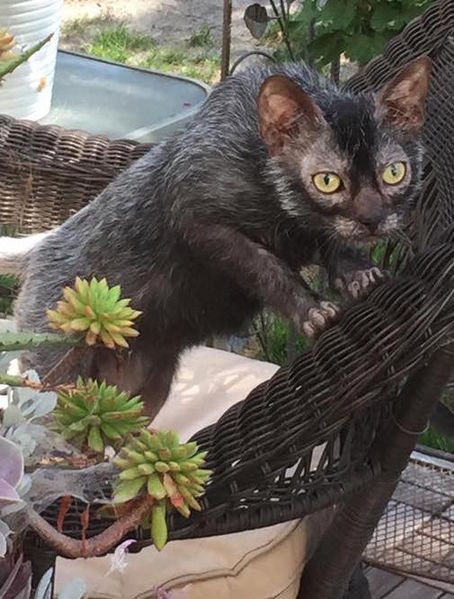
Determining the Best Hypoallergenic Hairless Cat Breed for You
Here are essential factors to consider when choosing a hairless cat breed for you. This will highlight to you he significance of interacting with different breeds to gauge allergy responses, and how to determine which cat is the best match for you.
Factors to Consider When Choosing a Hairless Cat Breed:
- Allergenic Potential: While hairless cat breeds generally have reduced allergenic potential, it’s crucial to understand that no cat is entirely hypoallergenic. Some individuals may still experience allergic reactions despite the breed’s hairlessness. Spend time with different hairless breeds to assess your allergic response.
- Grooming and Maintenance: Each hairless cat breed has specific grooming needs. Some may require more frequent baths and skincare than others. Consider the time and effort you can devote to grooming and choose a breed that aligns with your lifestyle.
- Temperament: Hairless cat breeds have diverse personalities. Some may be more affectionate and social, while others might be more independent. Take into account the temperament that best matches your preferences and household dynamics.
- Activity Level: Consider the activity level of the breed and how it aligns with your lifestyle. Some hairless cats are highly active and playful, while others may prefer a more relaxed and laid-back lifestyle.
Interacting with Different Breeds to Gauge Allergy Responses
One of the most critical steps in determining the best hypoallergenic hairless cat breed for you is spending time with different breeds. Visiting catteries, cat shows, or reputable breeders will provide opportunities to interact with various hairless cats and observe how your body responds to their presence.
For example, spend time with a Sphynx cat, a Donskoy, a Devon Rex, and other hairless breeds to gauge your allergic response. Notice any sneezing, itching, or respiratory issues that may arise during your interactions.
Take note of your allergic reactions and consider their intensity and duration. Allergies can be unpredictable and may vary from individual to individual. Spending time with multiple hairless breeds will give you a better understanding of which ones may be more compatible with your allergies.
Personal Lifestyle and Suitability with Hypoallergenic Hairless Cats
Consider how a hairless cat will fit into your lifestyle. Some important lifestyle factors to ponder include:
- Time and Attention: Hairless cats are social creatures and thrive on human interaction. Ensure you have enough time to devote to their care, playtime, and companionship.
- Living Space: Assess your living space and ensure it is suitable for a hairless cat. Consider how you will manage allergens in your home and if you have the space to accommodate a feline companion.
- Family Members: If you have family members with allergies, involve them in the process of choosing a hairless cat breed. Their input and allergic responses matter in making the right decision.
Remember that every cat, regardless of breed, has its unique personality and needs. Understanding your own lifestyle and preferences will help you choose a hypoallergenic hairless cat that best complements your home and brings joy to your life.
FAQ: Are Hairless Cats Hypoallergenic?
In this FAQ guide, we will address common questions about the hypoallergenic nature of hairless cats and provide essential information for allergy-prone individuals considering bringing a hairless cat into their home.
1. Are hairless cats completely hypoallergenic?
No, hairless cats are not completely hypoallergenic. Cat allergies are primarily triggered by allergenic proteins present in a cat’s saliva, skin, and urine, not their fur. Hairless cats still produce these allergenic proteins, although in smaller quantities compared to regular cat breeds.
2. What causes allergies in cat owners?
Cat allergies are caused by an individual’s immune system reacting to specific proteins in a cat’s body. The primary allergen responsible for triggering allergic reactions in cat owners is called Fel d 1, which is produced in a cat’s salivary glands and sebaceous glands.
3. How do I know if I’m allergic to hairless cats?
To determine if you are allergic to hairless cats, spend time interacting with different hairless breeds. Visit catteries, cat shows, or reputable breeders and observe how your body responds to their presence. Look for symptoms such as sneezing, itching, watery eyes, or respiratory issues during your interactions.
4. Can I still experience allergic reactions with hypoallergenic hairless cats?
Yes, you can still experience allergic reactions with hypoallergenic hairless cats. While hairless cats produce fewer allergenic proteins, they are not entirely allergen-free. If you have severe cat allergies, it’s essential to consult with a healthcare professional before considering cat ownership.
5. Are there any specific precautions for living with a hairless cat if I have allergies?
If you have allergies and are considering living with a hairless cat, there are several precautions you can take to minimize allergen exposure:
Regularly groom and bathe the cat to reduce allergenic proteins on their skin.
Use air purifiers and frequent cleaning to reduce allergens in the home.
Designate specific areas where the cat is allowed to roam to limit allergens in certain areas.
Wash your hands after interacting with the cat to minimize allergen transfer.
6. Which hairless cat breed is considered the most hypoallergenic?
Among hairless cat breeds, the Sphynx is often considered the most hypoallergenic. However, individual allergic responses may vary, so it’s essential to spend time with different hairless breeds to gauge your specific allergic reaction.
7. Do hairless cats require special grooming?
Yes, hairless cats require special grooming despite their lack of fur. Regular baths are necessary to remove skin oils and reduce allergenic proteins. Additionally, their skin may require moisturizing to prevent dryness.
8. Can hypoallergenic hairless cats be suitable for families with children?
Hypoallergenic hairless cats can be suitable for families with children, especially if the children have allergies. However, it’s essential to supervise interactions between the cat and young children to ensure a positive and safe environment for both.
9. How do I manage allergies while owning a hairless cat?
Managing allergies while owning a hairless cat involves a combination of strategies, including:
Regular grooming and skincare for the cat.
Keeping the home clean and using air purifiers to reduce allergens.
Taking allergy medications as prescribed by a healthcare professional.
10. What are some alternative hypoallergenic pets for cat lovers?
If you are allergic to cats but still want a pet, consider alternative hypoallergenic pets such as:
- Hypoallergenic dog breeds.
- Small pets like hamsters, guinea pigs, or rabbits.
- Fish or reptiles.
Remember to spend time with different pets to determine which one is the best fit for you and your allergies.
Conclusion: So, Are Hairless Cats Hypoallergenic?
The quest for a hypoallergenic hairless cat can be an exciting and rewarding journey for cat enthusiasts with allergies. We’ve highlighted above, essential points to consider when exploring the world of hairless cats and allergies.
Let’s recap the key takeaways from our discussion and offer some final thoughts to potential owners.
Recap of Key Points about Hairless Cats and Allergies:
- Hairless cats, such as the Sphynx, Bambino, Donskoy, Peterbald, Ukrainian Levkoy, Elf, Dwelf, Devon Rex, and Lykoi, are known for their reduced allergenic potential compared to regular cat breeds. However, they are not entirely hypoallergenic.
- Cat allergies are primarily triggered by specific proteins in a cat’s saliva, skin, and urine, not their fur. Hairless cats still produce these allergenic proteins, although in smaller quantities.
- Spending time with different hairless breeds and conducting allergy testing are essential steps for individuals with allergies to gauge their specific allergic response before considering cat ownership.
- Regular grooming and skincare are crucial for hairless cats to manage allergenic proteins on their skin and maintain a healthy coat.
Encouragement for Potential Owners to Conduct Thorough Research and Allergy Testing:
As you embark on the journey of choosing a hairless cat breed, we encourage you to conduct thorough research and take the time to interact with various breeds. Visiting catteries, attending cat shows, or consulting reputable breeders will provide valuable insights into each breed’s temperament and compatibility with your allergies.
Allergy testing is also a critical step in determining your specific allergic response. Consult with a healthcare professional or an allergist to understand your allergy triggers and potential severity. This knowledge will empower you to make an informed decision and ensure a harmonious living environment for both you and your future feline companion.
Final Thoughts on the Rewarding Experience of Owning a Hypoallergenic Hairless Cat:
Owning a hypoallergenic hairless cat can be an immensely rewarding experience for cat lovers with allergies. These unique breeds offer affection, companionship, and a sense of joy that enriches the lives of their owners. The bond between a cat and its owner is incredibly special, and the reduced allergenic potential of hairless cats can make this bond even more enjoyable for allergy-prone individuals.
As you prepare to welcome a hairless cat into your home, remember that every cat is an individual with its personality and needs. Provide them with love, attention, and proper care, and you’ll find yourself in the company of a devoted and loving companion.
In conclusion, while hairless cats are not entirely hypoallergenic, our key tips are:
- Taking the necessary precautions, conducting thorough research first.
- Understanding your allergies can pave the way for a wonderful and fulfilling relationship with a hypoallergenic hairless cat.
So, take that leap and embark on an adventure filled with love, laughter, and the joy of feline companionship.
